Iat MERCEDES-BENZ C-Class SEDAN 2016 W205 Owner's Manual
[x] Cancel search | Manufacturer: MERCEDES-BENZ, Model Year: 2016, Model line: C-Class SEDAN, Model: MERCEDES-BENZ C-Class SEDAN 2016 W205Pages: 398, PDF Size: 9.57 MB
Page 8 of 398
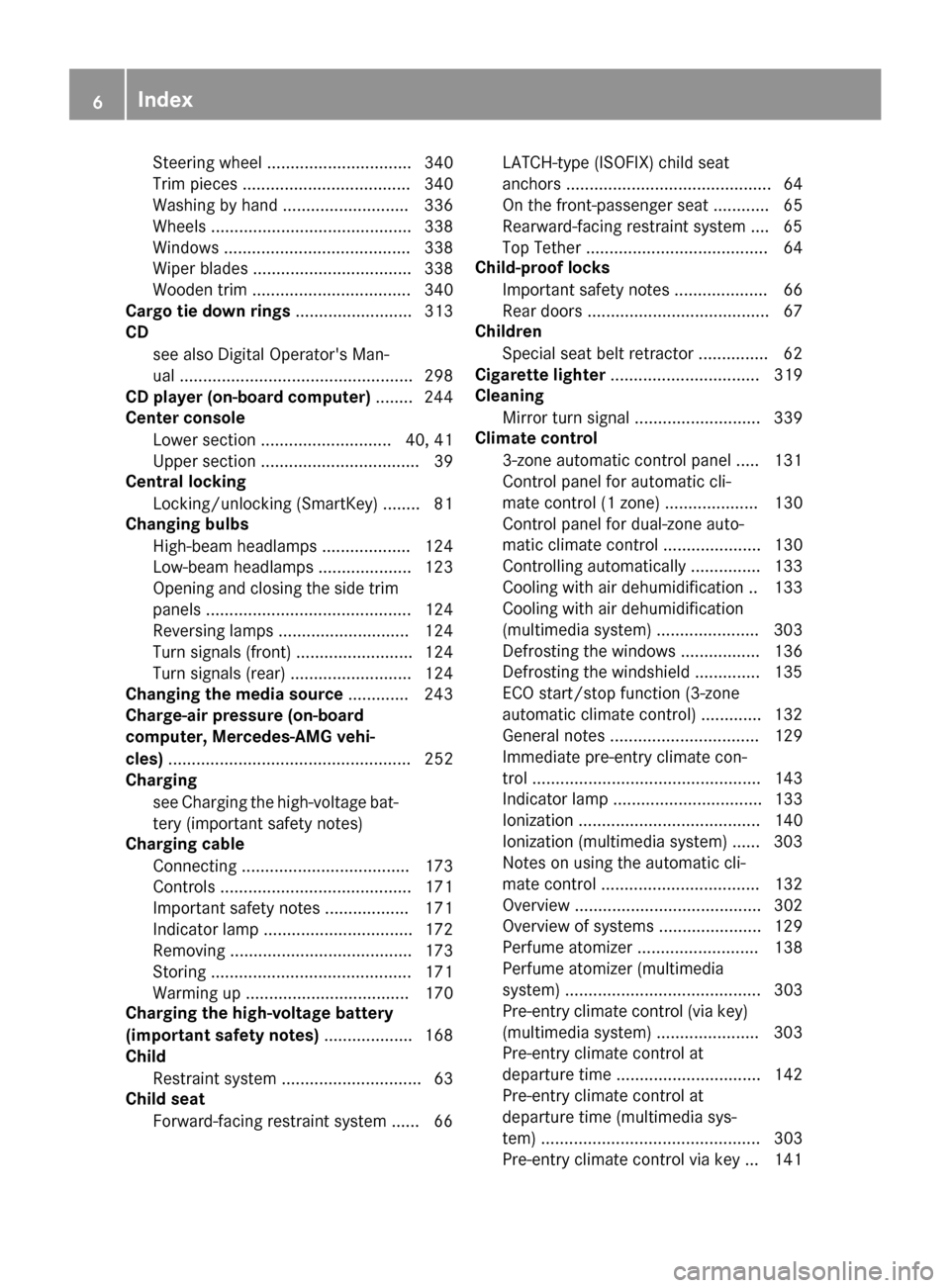
Steering wheel ............................... 340
Trim pieces .................................... 340
Washing by hand ........................... 336
Wheels ........................................... 338
Windows ........................................ 338
Wiper blades .................................. 338
Wooden trim .................................. 340
Cargo tie down rings ......................... 313
CD
see also Digital Operator's Man-
ual .................................................. 298
CD player (on-board computer) ........ 244
Center console
Lower section ............................ 40, 41
Upper section .................................. 39
Central locking
Locking/unlocking (SmartKey) ........ 81
Changing bulbs
High-beam headlamps ................... 124
Low-beam headlamps .................... 123
Opening and closing the side trim
panels ............................................ 124
Reversing lamps ............................ 124
Turn signals (front) ......................... 124
Turn signals (rear) .......................... 124
Changing the media source ............. 243
Charge-air pressure (on-board
computer, Mercedes-AMG vehi-
cles) .................................................... 252
Charging
see Charging the high-voltage bat-
tery (important safety notes)
Charging cable
Connecting .................................... 173
Controls ......................................... 171
Important safety notes .................. 171
Indicator lamp ................................ 172
Removing ....................................... 173
Storing ........................................... 171
Warming up ................................... 170
Charging the high-voltage battery
(important safety notes) ................... 168
Child
Restraint system .............................. 63
Child seat
Forward-facing restraint system ...... 66 LATCH-type (ISOFIX) child seat
anchors ............................................ 64
On the front-passenger seat ............ 65
Rearward-facing restraint system .... 65
Top Tether ....................................... 64
Child-proof locks
Important safety notes .................... 66
Rear doors ....................................... 67
Children
Special seat belt retractor ............... 62
Cigarette lighter ................................ 319
Cle
aning
Mirror turn signal ........................... 339
Climate control
3-zone automatic control panel ..... 131
Control panel for automatic cli-
mate control (1 zone) .................... 130
Control panel for dual-zone auto-
matic climate control ..................... 130
Controlling automatically ............... 133
Cooling with air dehumidification .. 133
Cooling with air dehumidification
(multimedia system) ...................... 303
Defrosting the windows ................. 136
Defrosting the windshield .............. 135
ECO start/stop function (3-zone
automatic climate control) ............. 132
General notes ................................ 129
Immediate pre-entry climate con-
trol ................................................. 143
Indicator lamp ................................ 133
Ionization ....................................... 140
Ionization (multimedia system) ...... 303
Notes on using the automatic cli-
mate control .................................. 132
Overview ........................................ 302
Overview of systems ...................... 129
Perfume atomizer .......................... 138
Perfume atomizer (multimedia
system) .......................................... 303
Pre-entry climate control (via key)
(multimedia system) ...................... 303
Pre-entry climate control at
departure time ............................... 142
Pre-entry climate control at
departure time (multimedia sys-
tem) ............................................... 303
Pre-entry climate control via key ... 141
6Index
Page 14 of 398
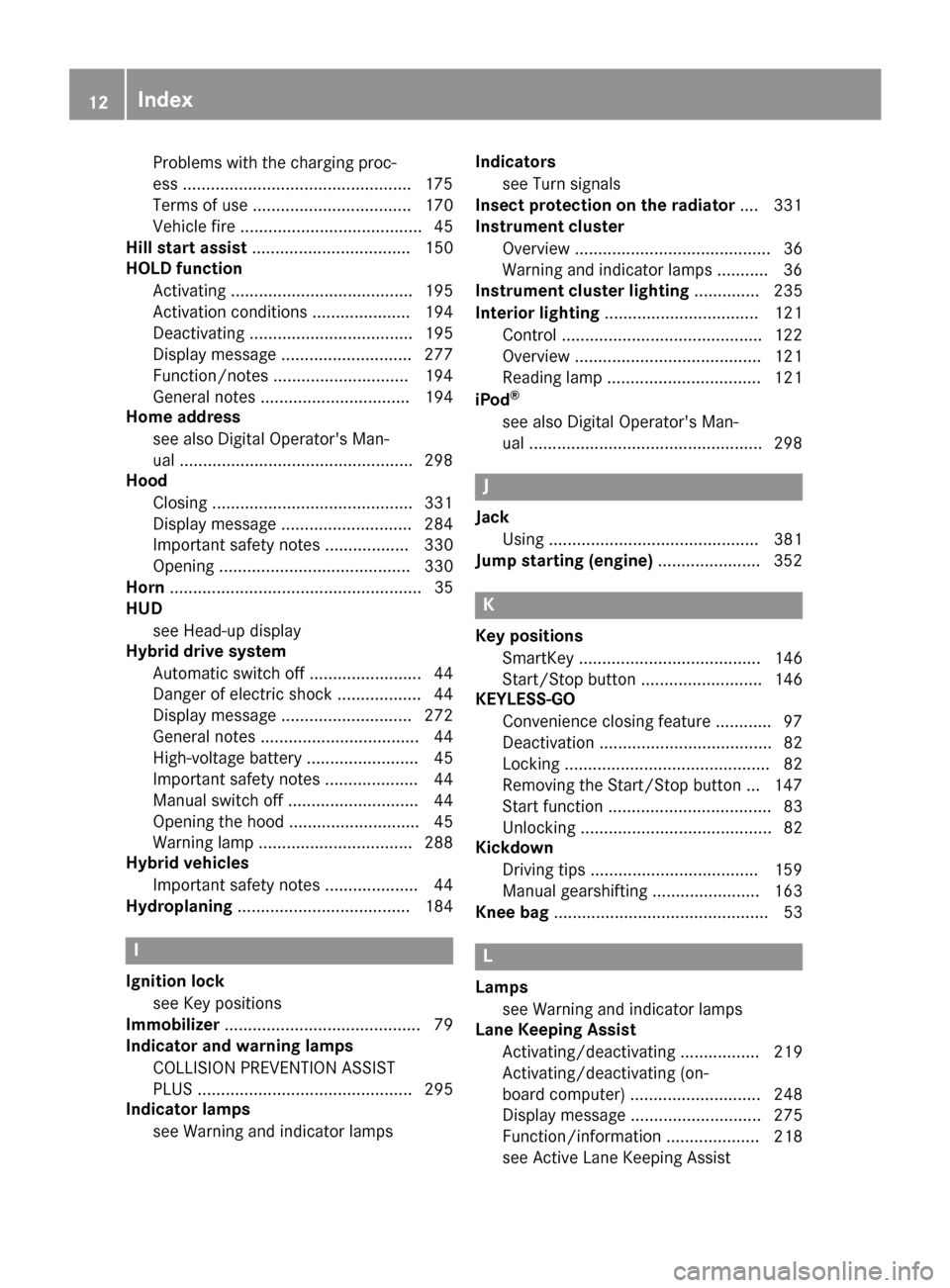
Problems with the charging proc-
ess .................................................175
Terms of use .................................. 170
Vehicle fire ....................................... 45
Hill start assist .................................. 150
HOLD function
Activating ....................................... 195
Activation conditions ..................... 194
Deactivating ................................... 195
Display message ............................ 277
Function/notes .............................1 94
General notes ................................ 194
Home address
see also Digital Operator's Man-
ual ..................................................2 98
Hood
Closing ...........................................3 31
Display message ............................ 284
Important safety notes .................. 330
Opening ......................................... 330
Horn ...................................................... 35
HUD
see Head-up display
Hybrid drive system
Automatic switch off ........................ 44
Danger of electric shock .................. 44
Display message ............................ 272
General notes .................................. 44
High-voltage battery ........................ 45
Important safety notes .................... 44
Manual switch off ............................ 44
Opening the hood ............................ 45
Warning lamp ................................. 288
Hybrid vehicles
Important safety notes .................... 44
Hydroplaning ..................................... 184
I
Ignition lock
see Key positions
Immobilizer .......................................... 79
Indicator and warning lamps
COLLISION PREVENTION ASSIST
PLUS .............................................. 295
Indicator lamps
see Warning and indicator lamps Indicators
see Turn signals
Insect protection on the radiator .... 331
Instrument cluster
Overview .......................................... 36
Warning and indicator lamps ........... 36
Instrument cluster lighting .............. 235
Interior lighting ................................. 121
Control ...........................................1 22
Overview ........................................ 121
Reading lamp ................................. 121
iPod
®
see also Digital Operator's Man-
ual ..................................................2 98
J
Jack
Using ............................................. 381
Jump starting (engine) ......................352
K
Key positions
SmartKey ....................................... 146
Start/Stop button .......................... 146
KEYLESS-GO
Convenience closing feature ............ 97
Deactivation ..................................... 82
Locking ............................................ 82
Removing the Start/Stop button ... 147
Start function ................................... 83
Unlocking ......................................... 82
Kickdown
Driving tips ....................................1 59
Manual gearshifting ....................... 163
Knee bag .............................................. 53
L
Lamps
see Warning and indicator lamps
Lane Keeping Assist
Activating/deactivating ................. 219
Activating/deactivating (on-
board computer) ............................ 248
Display message ............................ 275
Function/information .................... 218
see Active Lane Keeping Assist
12Index
Page 19 of 398
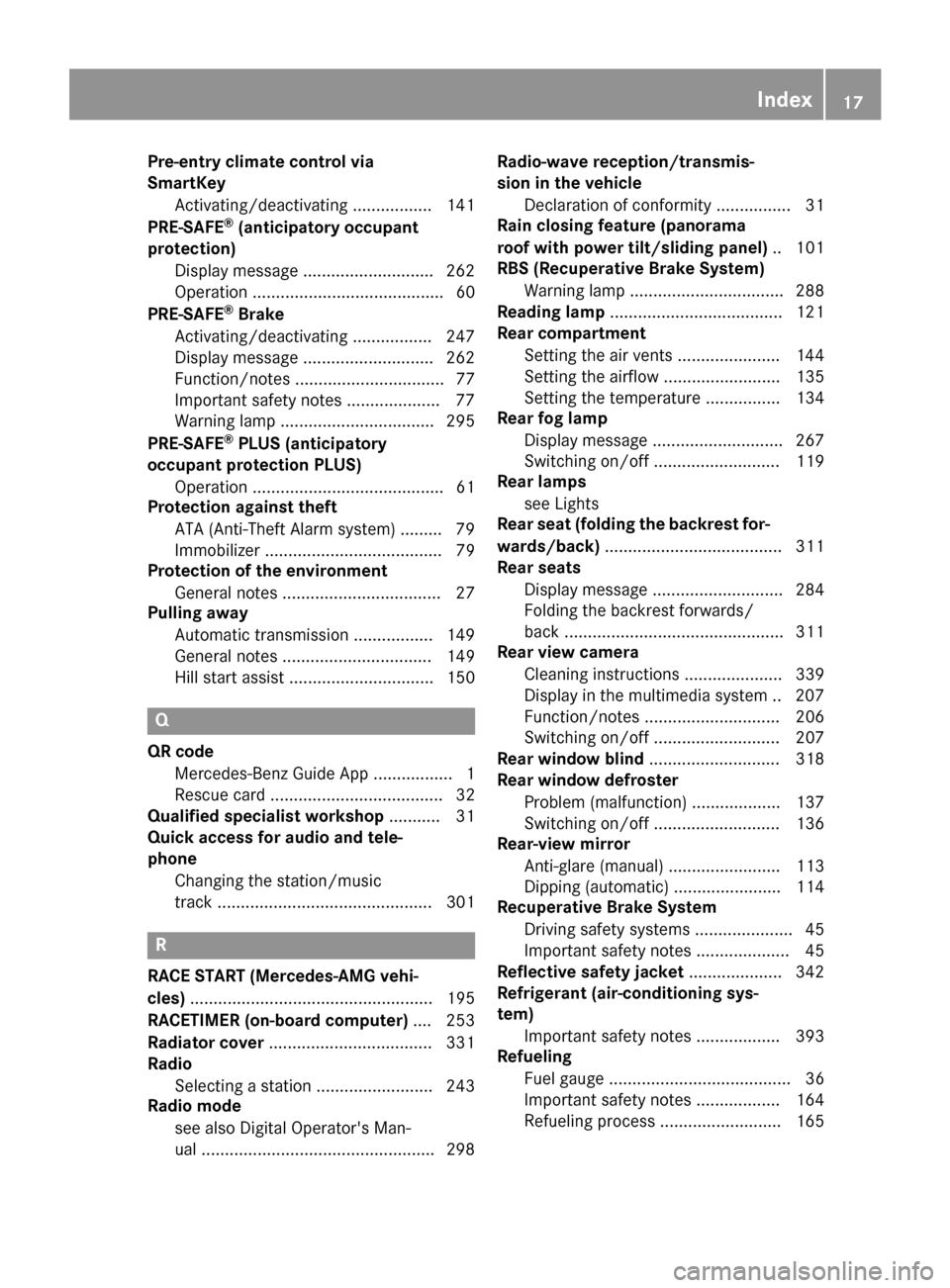
Pre-entry climate control via
SmartKeyActivating/deactivating ................. 141
PRE-SAFE
®(anticipatory occupant
protection)
Display message ............................2 62
Operation ......................................... 60
PRE-SAFE
®Brake
Activating/deactivating ................. 247
Display message ............................ 262
Function/notes ................................ 77
Important safety notes .................... 77
Warning lamp ................................. 295
PRE-SAFE
®PLUS (anticipatory
occupant protection PLUS)
Operation ......................................... 61
Protection against theft
ATA (Anti-Theft Alarm system) ......... 79
Immobilizer ...................................... 79
Protection of the environment
General notes .................................. 27
Pulling away
Automatic transmission ................. 149
General notes ................................ 149
Hill start assist ............................... 150
Q
QR codeMercedes-Benz Guide App ................. 1
Rescue card ..................................... 32
Qualified specialist workshop ........... 31
Quick access for audio and tele-
phone
Changing the station/music
track .............................................. 301
R
RACE START (Mercedes-AMG vehi-
cles) .................................................... 195
RACETIMER (on-board computer) .... 253
Radiator cover ................................... 331
Radio
Selecting a station ......................... 243
Radio mode
see also Digital Operator's Man-
ual ..................................................2 98Radio-wave reception/transmis-
sion in the vehicle
Declaration of conformity ................ 31
Rain closing feature (panorama
roof with power tilt/sliding panel) .. 101
RBS (Recuperative Brake System)
Warning lamp ................................. 288
Reading lamp ..................................... 121
Rear compartment
Setting the air vents ......................1 44
Setting the airflow ......................... 135
Setting the temperature ................ 134
Rear fog lamp
Display message ............................ 267
Switching on/off ........................... 119
Rear lamps
see Lights
Rear seat (folding the backrest for-
wards/back) ...................................... 311
Rear seats
Display message ............................ 284
Folding the backrest forwards/
back ............................................... 311
Rear view camera
Cleaning instructions ..................... 339
Display in the multimedia system .. 207
Function/notes .............................2 06
Switching on/off ........................... 207
Rear window blind ............................ 318
Rear window defroster
Problem (malfunction) ................... 137
Switching on/off ........................... 136
Rear-view mirror
Anti-glare (manual) ........................ 113
Dipping (automatic) ....................... 114
Recuperative Brake System
Driving safety systems ..................... 45
Important safety notes .................... 45
Reflective safety jacket .................... 342
Refrigerant (air-conditioning sys-
tem)
Important safety notes .................. 393
Refueling
Fuel gauge ....................................... 36
Important safety notes ....... ........... 164
R
efueling process .......................... 165
Index17
Page 26 of 398
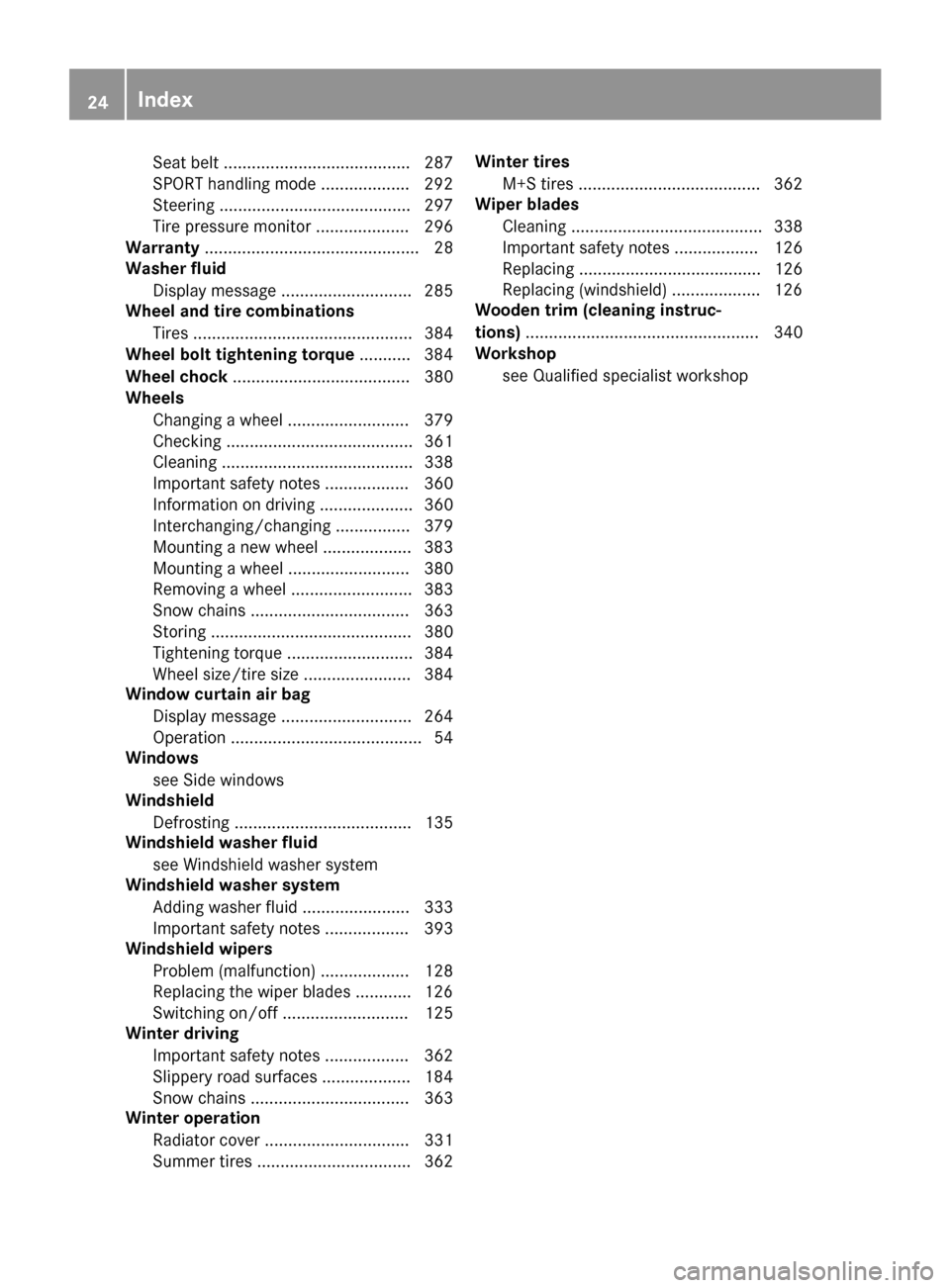
Seat belt ........................................ 287
SPORT handling mode ................... 292
Steering ......................................... 297
Tire pressure monitor .................... 296
Warranty .............................................. 28
Washer fluid
Display message ............................ 285
Wheel and tire combinations
Tires ............................................... 384
Wheel bolt tightening torque ........... 384
Wheel chock ...................................... 380
Wheels
Changing a wheel .......................... 379
Checking ........................................ 361
Cleaning ......................................... 338
Important safety notes .................. 360
Information on driving .................... 360
Interchanging/changing ................ 379
Mounting a new wheel ................... 383
Mounting a wheel .......................... 380
Removing a wheel .......................... 383
Snow chains .................................. 363
Storing ........................................... 380
Tightening torque ........................... 384
Wheel size/tire size ....................... 384
Window curtain air bag
Display message ............................ 264
Operation ......................................... 54
Windows
see Side windows
Windshield
Defrosting ...................................... 135
Windshield washer fluid
see Windshield washer system
Windshield washer system
Adding washer fluid ....................... 333
Important safety notes .................. 393
Windshield wipers
Problem (malfunction) ................... 128
Replacing the wiper blades ............ 126
Switching on/off ........................... 125
Winter driving
Important safety notes .................. 362
Slippery road surfaces ................... 184
Snow chains .................................. 363
Winter operation
Radiator cover ............................... 331
Summer tires ................................. 362 Winter tires
M+S tires ....................................... 362
Wiper blades
Cleaning ......................................... 338
Important safety notes .................. 126
Replacing ....................................... 126
Replacing (windshield) ................... 126
Wooden trim (cleaning instruc-
tions) .................................................. 340
Workshop
see Qualified specialist workshop
24Index
Page 32 of 398
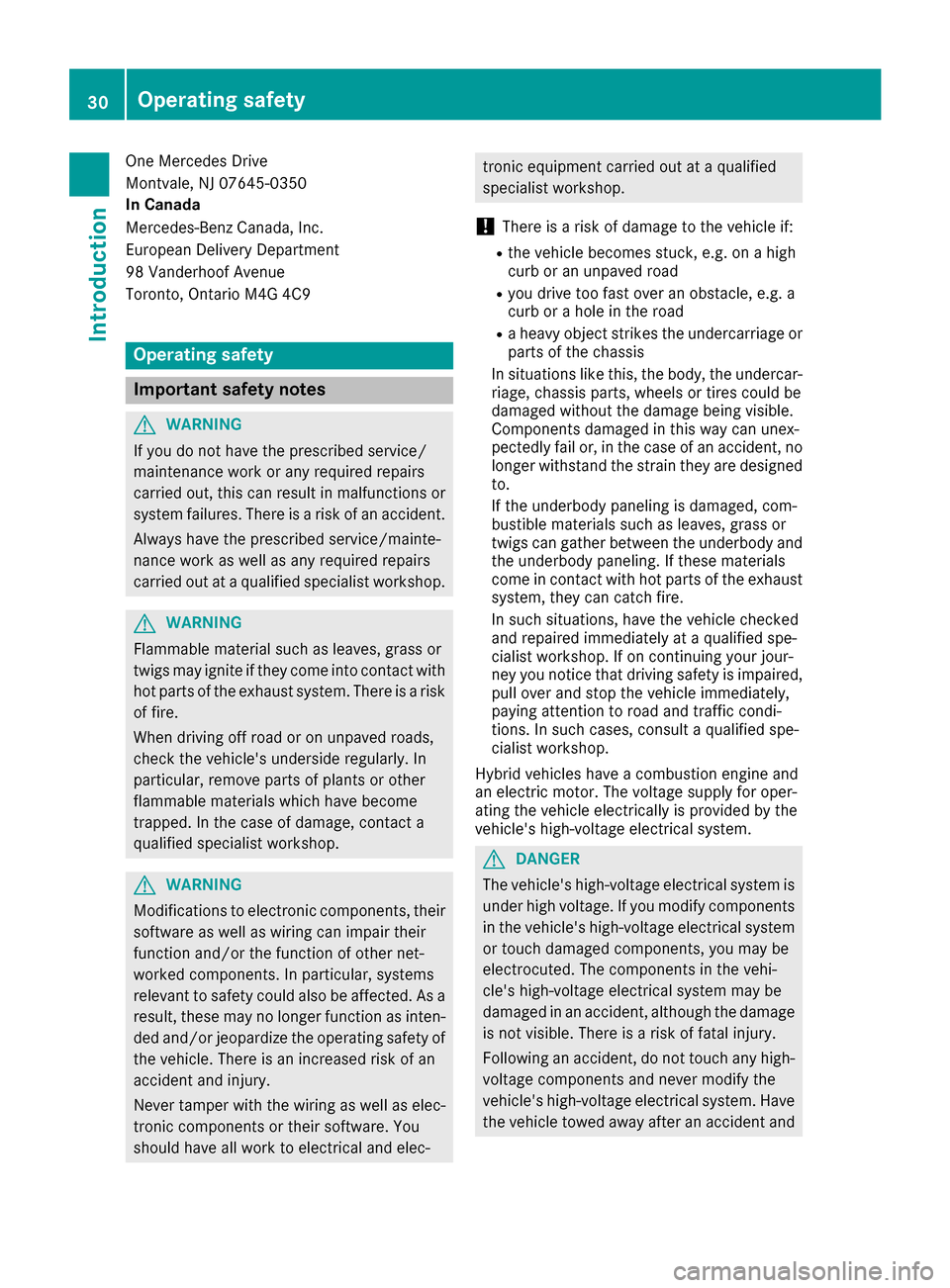
One Mercedes Drive
Montvale, NJ 07645-0350
In Canada
Mercedes-Benz Canada, Inc.
European Delivery Department
98 Vanderhoof Avenue
Toronto, Ontario M4G 4C9
Operating safety
Important safety notes
GWARNING
If you do not have the prescribed service/
maintenance work or any required repairs
carried out, this can result in malfunctions or system failures. There is a risk of an accident.
Always have the prescribed service/mainte-
nance work as well as any required repairs
carried out at a qualified specialist workshop.
GWARNING
Flammable material such as leaves, grass or
twigs may ignite if they come into contact with
hot parts of the exhaust system. There is a risk of fire.
When driving off road or on unpaved roads,
check the vehicle's underside regularly. In
particular, remove parts of plants or other
flammable materials which have become
trapped. In the case of damage, contact a
qualified specialist workshop.
GWARNING
Modifications to electronic components, their software as well as wiring can impair their
function and/or the function of other net-
worked components. In particular, systems
relevant to safety could also be affected. As a
result, these may no longer function as inten-
ded and/or jeopardize the operating safety of
the vehicle. There is an increased risk of an
accident and injury.
Never tamper with the wiring as well as elec-
tronic components or their software. You
should have all work to electrical and elec-
tronic equipment carried out at a qualified
specialist workshop.
!There is a risk of damage to the vehicle if:
Rthe vehicle becomes stuck, e.g. on a high
curb or an unpaved road
Ryou drive too fast over an obstacle, e.g. a
curb or a hole in the road
Ra heavy object strikes the undercarriage or
parts of the chassis
In situations like this, the body, the undercar-
riage, chassis parts, wheels or tires could be
damaged without the damage being visible.
Components damaged in this way can unex-
pectedly fail or, in the case of an accident, no
longer withstand the strain they are designed to.
If the underbody paneling is damaged, com-
bustible materials such as leaves, grass or
twigs can gather between the underbody and
the underbody paneling. If these materials
come in contact with hot parts of the exhaust
system, they can catch fire.
In such situations, have the vehicle checked
and repaired immediately at a qualified spe-
cialist workshop. If on continuing your jour-
ney you notice that driving safety is impaired,
pull over and stop the vehicle immediately,
paying attention to road and traffic condi-
tions. In such cases, consult a qualified spe-
cialist workshop.
Hybrid vehicles have a combustion engine and
an electric motor. The voltage supply for oper-
ating the vehicle electrically is provided by the
vehicle's high-voltage electrical system.
GDANGER
The vehicle's high-voltage electrical system is under high voltage. If you modify components
in the vehicle's high-voltage electrical system
or touch damaged components, you may be
electrocuted. The components in the vehi-
cle's high-voltage electrical system may be
damaged in an accident, although the damage
is not visible. There is a risk of fatal injury.
Following an accident, do not touch any high-
voltage components and never modify the
vehicle's high-voltage electrical system. Have
the vehicle towed away after an accident and
30Operating safety
Introduction
Page 34 of 398

Correct use
If you remove any warning stickers, you or oth-
ers could fail to recognize certain dangers.
Leave warning stickers in position.
Observe the following information when driving
your vehicle:
Rthe safety notes in this manual
Rthe vehicle technical data
Rtraffic rules and regulations
Rlaws and safety standards pertaining to motor
vehicles
Problems with your vehicle
If you should experience a problem with your
vehicle, particularly one that you believe may
affect its safe operation, we urge you to contact
an authorized Mercedes-Benz Center immedi-
ately to have the problem diagnosed and recti-
fied. If the problem is not resolved to your sat-
isfaction, please discuss the problem again with
a Mercedes-Benz Center or contact us at one of
the following addresses.
In the USA
Customer Assistance Center
Mercedes-Benz USA, LLC
One Mercedes Drive
Montvale, NJ 07645-0350
In Canada
Customer Relations Department
Mercedes-Benz Canada, Inc.
98 Vanderhoof Avenue
Toronto, Ontario M4G 4C9
Reporting safety defects
USA only:
The following text is published as required of
manufacturers under Title 49, Code of U.S. Fed-
eral Regulations, Part 575 pursuant to the
"National Traffic and Motor Vehicle Safety Act of 1966".
If you believe that your vehicle has a defect
which could cause a crash or could cause injury
or death, you should immediately inform the
National Highway Traffic Safety Administration
(NHTSA) in addition to notifying Mercedes-Benz
USA, LLC. If NHTSA receives similar complaints, it may
open an investigation, and if it finds that a safety
defect exists in a group of vehicles, it may order
a recall and remedy campaign. However, NHTSA
cannot become involved in individual problems
between you, your dealer, or Mercedes-Benz
USA, LLC.
To contact NHTSA, you may call the Vehicle
Safety Hotline toll-free at
1-888-327-4236(TTY: 1-800-424-9153
);go to
http://www.safercar.gov ; or write to: Admin-
istrator, NHTSA, 400 Seventh Street, SW.,
Washington, DC 20590.
You can also obtain other information about
motor vehicle safety from
http://www.safercar.gov
Limited Warranty
!
Follow the instructions in this manual about
the proper operation of your vehicle as well as
about possible vehicle damage. Damage to
your vehicle that arises from culpable contra-
ventions against these instructions is not cov-
ered either by the Mercedes-Benz Limited
Warranty or by the New or Used-Vehicle War-
ranty.
QR codes for the rescue card
The QR codes are secured in the fuel filler flap
and on the opposite side on the B-pillar. In the
event of an accident, rescue services can use
the QR code to quickly find the appropriate res-
cue card for your vehicle. The current rescue
card contains the most important information
about your vehicle in a compact form, e.g. the
routing of the electric cables.
You can find more information under http://
portal.aftersales.i.daimler.com/public/
content/asportal/en/communication/
informationen_fuer/QRCode.html.
Data stored in the vehicle
Data storage
A wide range of electronic components in your
vehicle contain data memories.
32Data stored in the vehicle
Introduction
Page 36 of 398
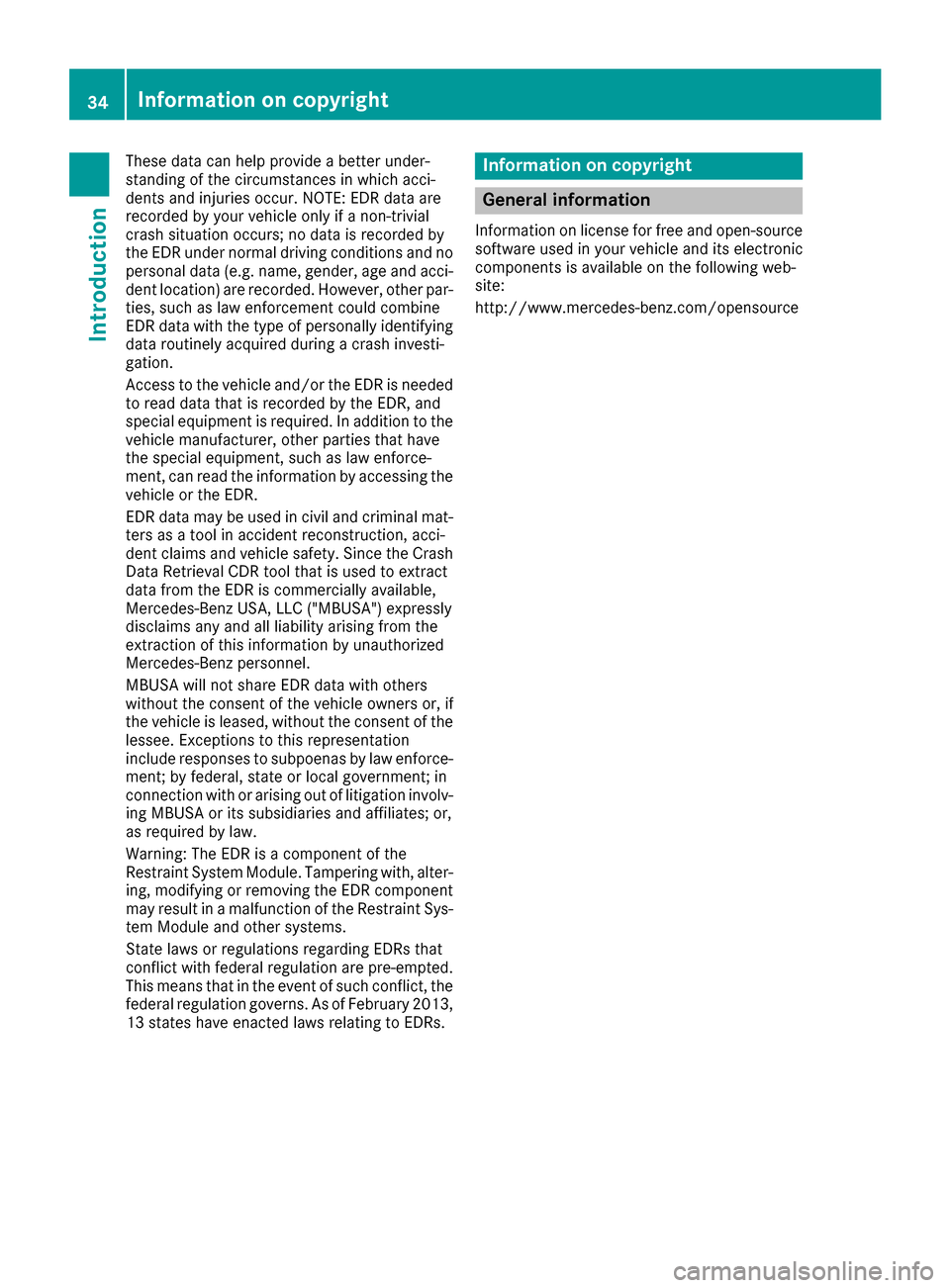
These data can help provide a better under-
standing of the circumstances in which acci-
dents and injuries occur. NOTE: EDR data are
recorded by your vehicle only if a non-trivial
crash situation occurs; no data is recorded by
the EDR under normal driving conditions and no
personal data (e.g. name, gender, age and acci-dent location) are recorded. However, other par-
ties, such as law enforcement could combine
EDR data with the type of personally identifyingdata routinely acquired during a crash investi-
gation.
Access to the vehicle and/or the EDR is needed
to read data that is recorded by the EDR, and
special equipment is required. In addition to the vehicle manufacturer, other parties that have
the special equipment, such as law enforce-
ment, can read the information by accessing the
vehicle or the EDR.
EDR data may be used in civil and criminal mat-
ters as a tool in accident reconstruction, acci-
dent claims and vehicle safety. Since the Crash
Data Retrieval CDR tool that is used to extract
data from the EDR is commercially available,
Mercedes-Benz USA, LLC ("MBUSA") expressly
disclaims any and all liability arising from the
extraction of this information by unauthorized
Mercedes-Benz personnel.
MBUSA will not share EDR data with others
without the consent of the vehicle owners or, if
the vehicle is leased, without the consent of the
lessee. Exceptions to this representation
include responses to subpoenas by law enforce-
ment; by federal, state or local government; in
connection with or arising out of litigation involv-ing MBUSA or its subsidiaries and affiliates; or,
as required by law.
Warning: The EDR is a component of the
Restraint System Module. Tampering with, alter-
ing, modifying or removing the EDR component
may result in a malfunction of the Restraint Sys-
tem Module and other systems.
State laws or regulations regarding EDRs that
conflict with federal regulation are pre-empted.
This means that in the event of such conflict, the federal regulation governs. As of February 2013,
13 states have enacted laws relating to EDRs.Information on copyright
General information
Information on license for free and open-source
software used in your vehicle and its electronic
components is available on the following web-
site:
http://www.mercedes-benz.com/opensource
34Information on copyright
Introduction
Page 47 of 398

XIf possible, move the vehicle out of the
danger zone:shift the transmission into posi-
tion N.
XRelease the electric parking brake.
XRoll the vehicle to a safe place and park it
safely.
Get assistance from others if necessary.
The vehicle is locked automatically when the
ignition is switched on and the wheels are turn-
ing. There is therefore a risk of being locked out
if the vehicle is being pushed or tested on a
dynamometer.
XSwitch the ignition off.
XShift the transmission to position P.
Depress the electric parking brake
(
Ypage 178).
Secure the vehicle against rolling away
(
Ypage 380).
XTo use the high-voltage switch-off device:
open the hood.
XPress release clip :in the direction of the
arrow and pull it out.
XPull the high voltage switch-off device ;
apart until it engages in the stop position.
If the hybrid drive system has been deactivated
due to reasons mentioned above, have it
checked at a qualified specialist workshop
before reactivation.
High-voltage battery
GWARNING
In the event of a vehicle fire, the internal pres- sure of the high-voltage battery can exceed a
critical value. In this case flammable gas
escapes through a ventilation valve on the
underbody. The gas can ignite. There is a risk
of injury.
Leave the danger zone immediately. Secure
the danger area at a suitable distance, whilst
observing legal requirements.
GWARNING
If the housing of the high-voltage battery has
been damaged, electrolyte and gases may
leak out. These are poisonous and caustic.
There is a risk of injury.
Avoid contact with skin, eyes or clothing.
Immediately rinse electrolyte splashes off
with water and seek medical attention
straight away.
PLUG-IN HYBRID vehicles: charging the high-
voltage battery (
Ypage 168).
Engine compartment
Before opening the hood:
XApply the electric parking brake.
XShift the transmission to position P.
XSwitch the ignition off.
XRemove the SmartKey from the ignition lock.
or, in vehicles with KEYLESS-GO start-function
or KEYLESS ‑GO
XRemove the Start/Stop button from the igni-
tion lock.
XObserve the warning notes on the risk of elec-
tric shock (Ypage 44).
XObserve the warning notices about the hood
(Ypage 330).
RBS driving safety system (Recupera-
tive Brake System)
The Recuperative Brake System supports you
when braking with an electronically-controlled
brake boost mode and enables the recovery of
kinetic energy (recuperation).
Further information about the Recuperative
Brake System (
Ypage 225).
Hybrid vehicles45
Safety
Z
Page 49 of 398

regular intervals while the engine is running.
Therefore, malfunctions can be detected in
good time.
The6 restraint system warning lamp in the
instrument cluster lights up when the ignition is
switched on. It goes out no later than a few sec-
onds after the vehicle is started. The compo-
nents of the restraint system are in operational
readiness.
A malfunction has occurred if the 6restraint
system warning lamp:
Rdoes not light up after the ignition is switched
on
Rdoes not go out after a few seconds with the
engine running
Rlights up again while the engine is running
All vehicles, except hybrid vehicles:
GWARNING
If restraint system is malfunctioning, restraint
system components may be triggered unin-
tentionally or might not be triggered at all in
the event of an accident with a high rate of
vehicle deceleration. This can affect the Emer- gency Tensioning Device or air bag, for exam-
ple. This poses an increased risk of injury or
even fatal injury.
Have the restraint system checked and
repaired in a qualified specialist workshop as
soon as possible.
Hybrid vehicles:
GDANGER
If the restraint system is malfunctioning, indi- vidual restraint system components may be
triggered unintentionally or might not be trig-
gered at all in the event of an accident with a
high rate of vehicle deceleration. This could
affect Emergency Tensioning Devices or air
bags, for example. The vehicle's high-voltage
electrical system may also not be deactivated
as intended in the event of an accident. You
could suffer an electric shock if you touch the
damaged components of the vehicle's high-
voltage electrical system. This poses an
increased risk of injury or even fatal injury.
Have the restraint system checked and
repaired immediately at a qualified specialist
workshop. Immediately switch off the ignitionand remove the SmartKey from the ignition
lock after an accident.
PASSENGER AIR BAG indicator lamp
PASSENGER AIR BAG ON indicator lamp :and
PASSENGER AIR BAG OFF indicator lamp ;are
part of the Occupant Classification System
(OCS).
The indicator lamps display the status of the
front-passenger front air bag.
RPASSENGER AIR BAG ON lights up: the front-
passenger front air bag is enabled. If, in the
event of an accident, all deployment criteria
are met, the front-passenger front air bag is
deployed.
RPASSENGER AIR BAG OFF lights up: the front-
passenger front air bag is deactivated. It will
then not be deployed in the event of an acci-
dent.
Depending on the person in the front-passenger
seat, the front-passenger front air bag must
either be deactivated or enabled; see the fol-
lowing points. You must make sure of this both
before and during a journey.
RChildren in a child restraint system:
whether the front-passenger front air bag is
enabled or deactivated depends on the instal-
led child restraint system, and the age and
size of the child. Therefore, be sure to observe
the notes on the "Occupant Classification
System (OCS)" (
Ypage 54) and on "Chil-
dren in the vehicle" (Ypage 62). There you
will also find instructions on rearward and
forward-facing child restraint systems on the
front-passenger seat.
RAll other persons: depending on the classi-
fication of the person in the front-passenger
Occupant safety47
Safety
Z
Page 51 of 398
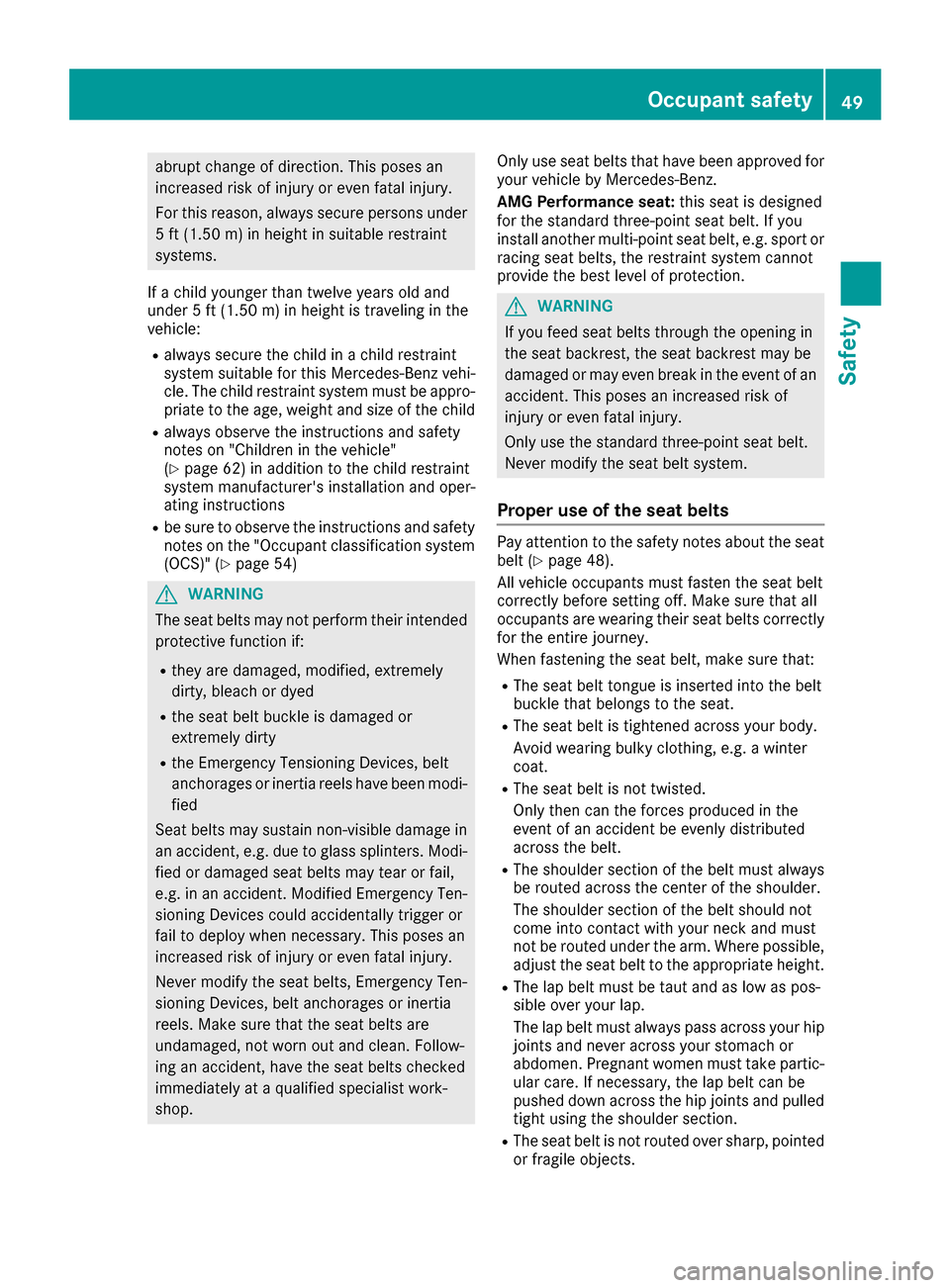
abrupt change of direction. This poses an
increased risk of injury or even fatal injury.
For this reason, always secure persons under
5 ft (1.50 m) in height in suitable restraint
systems.
If a child younger than twelve years old and
under 5 ft (1.50m) in height is traveling in the
vehicle:
Ralways secure the child in a child restraint
system suitable for this Mercedes-Benz vehi-
cle. The child restraint system must be appro-
priate to the age, weight and size of the child
Ralways observe the instructions and safety
notes on "Children in the vehicle"
(
Ypage 62) in addition to the child restraint
system manufacturer's installation and oper-
ating instructions
Rbe sure to observe the instructions and safety
notes on the "Occupant classification system
(OCS)" (
Ypage 54)
GWARNING
The seat belts may not perform their intended protective function if:
Rthey are damaged, modified, extremely
dirty, bleach or dyed
Rthe seat belt buckle is damaged or
extremely dirty
Rthe Emergency Tensioning Devices, belt
anchorages or inertia reels have been modi-
fied
Seat belts may sustain non-visible damage in an accident, e.g. due to glass splinters. Modi-
fied or damaged seat belts may tear or fail,
e.g. in an accident. Modified Emergency Ten-
sioning Devices could accidentally trigger or
fail to deploy when necessary. This poses an
increased risk of injury or even fatal injury.
Never modify the seat belts, Emergency Ten-
sioning Devices, belt anchorages or inertia
reels. Make sure that the seat belts are
undamaged, not worn out and clean. Follow-
ing an accident, have the seat belts checked
immediately at a qualified specialist work-
shop. Only use seat belts that have been approved for
your vehicle by Mercedes-Benz.
AMG Performance seat:
this seat is designed
for the standard three-point seat belt. If you
install another multi-point seat belt, e.g. sport or
racing se at b
elts, the restraint system cannot
provide the best level of protection.
GWARNING
If you feed seat belts through the opening in
the seat backrest, the seat backrest may be
damaged or may even break in the event of an accident. This poses an increased risk of
injury or even fatal injury.
Only use the standard three-point seat belt.
Never modify the seat belt system.
Proper use of the seat belts
Pay attention to the safety notes about the seat
belt (Ypage 48).
All vehicle occupants must fasten the seat belt
correctly before setting off. Make sure that all
occupants are wearing their seat belts correctly
for the entire journey.
When fastening the seat belt, make sure that:
RThe seat belt tongue is inserted into the belt
buckle that belongs to the seat.
RThe seat belt is tightened across your body.
Avoid wearing bulky clothing, e.g. a winter
coat.
RThe seat belt is not twisted.
Only then can the forces produced in the
event of an accident be evenly distributed
across the belt.
RThe shoulder section of the belt must always
be routed across the center of the shoulder.
The shoulder section of the belt should not
come into contact with your neck and must
not be routed under the arm. Where possible,
adjust the seat belt to the appropriate height.
RThe lap belt must be taut and as low as pos-
sible over your lap.
The lap belt must always pass across your hip
joints and never across your stomach or
abdomen. Pregnant women must take partic-
ular care. If necessary, the lap belt can be
pushed down across the hip joints and pulled
tig ht u
sing the shoulder section.
RThe seat belt is not routed over sharp, pointed
or fragile objects.
Occupant safety49
Safety
Z